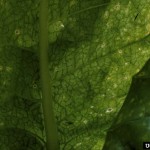Potato Virus (PVY)
Recommended resistant varieties: NC 291, CC 55
Pictures provided by R.J. Reynolds Tobacco Company Slide Set, R.J. Reynolds Tobacco Company, bugwood.org
An infection of PVY is initially indicated by a whitening of the veins of the leaves. Later, the leaves dark green stripes along the veins associated with light green leaf tissue surrounding the veins. This is commonly referred to as vein banding. This condition is often associated with the development of a light mottled color in the remaining leaf tissue. More severe types of PVY result in the necrosis of the veins of the infected plants.
Systemic necrosis often plagues cultivars which are resistant to root knot nematodes. As the lower leaves ripen, the veins on these leaves turn black. The death of the plant occurs shortly after and the leaves begin to fall off the stalk. Additionally, the stalk may split longitudinally and areas of necrosis indicated by black discoloration may be seen from the bottom to the top of the stalk. PVY resistant varieties which become infected in early stages of development my show weak symptoms without the death of the plant.
This virus is transmitted from vegetables and weeds to tobacco by migrating aphids. Plant beds or fields near potato crops, vegetables or weed infested areas should be avoided.
The use of varieties which are PVY resistant is the most effect way to prevent loss cause by PVY damage. However, it is still very important to ally insecticides for controlling aphids and other insects, which transmit the PVY virus as well as other diseases.


